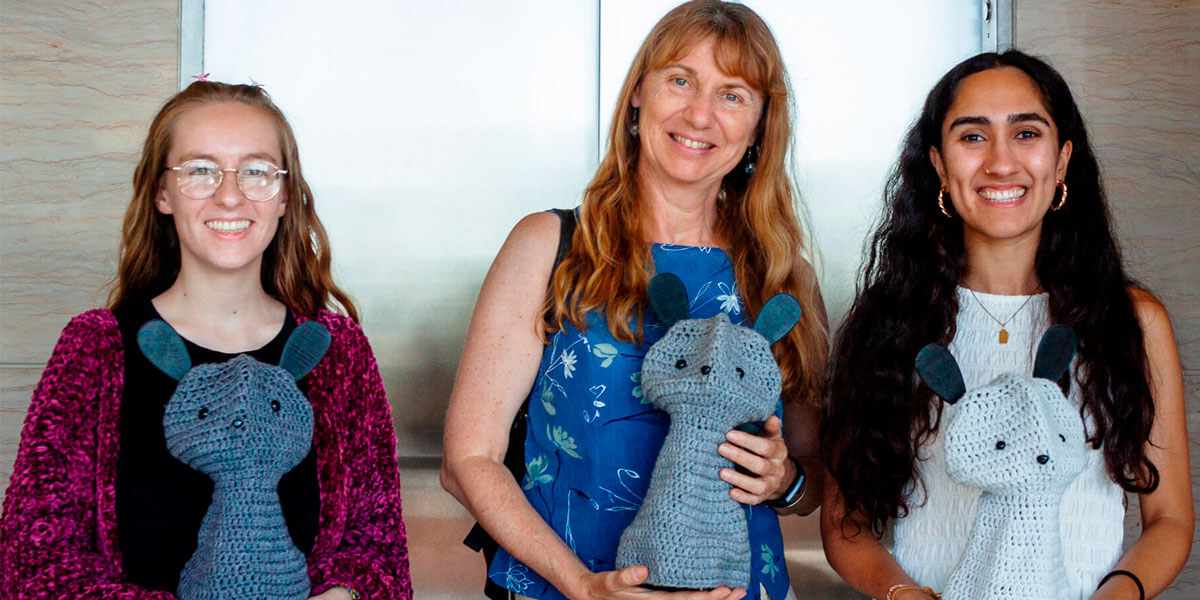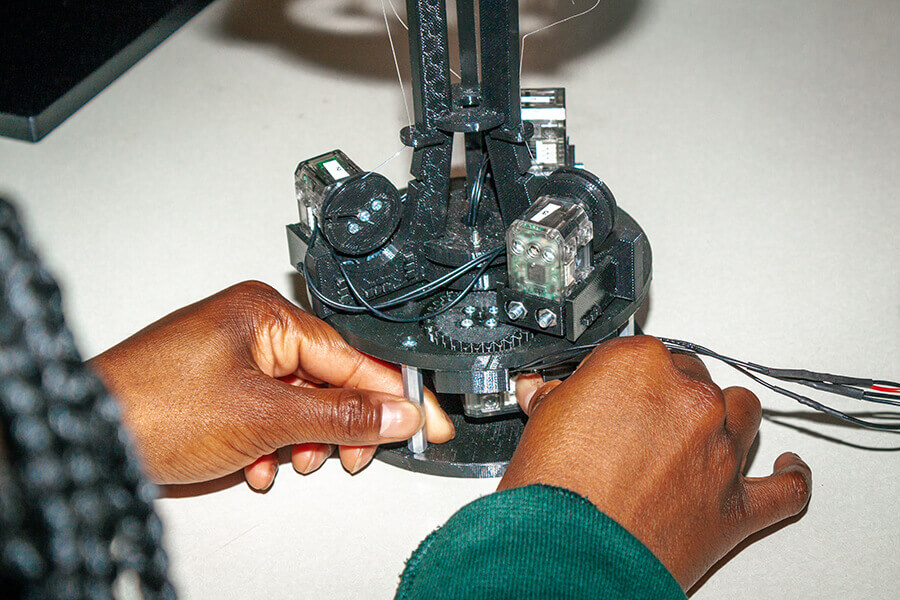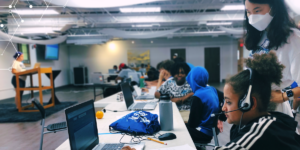
Professor Maja Matarić (center) and doctoral students Amy O’Connell (left) and Mina Kian (right) with a trio of Blossom robots.
The scene: In a dorm room on campus, sophomore Jo struggles to focus on her homework. She can feel the all-too-familiar restlessness kicking in.
Alright, focus, focus, she tells herself. But wait, did she leave her laundry pile like that? It’s begging to be folded. Maybe I’ll just fold five things and then get back to the essay.
The blank page on her laptop beckons. No, no, no. Focus. Laundry can wait.
OK, an introduction to the impact of social media on relationships …
Was that a notification on my phone? Oh, it’s an email. Must. Resist. Temptation. But wait, wasn’t I meant to be getting the grade on that last assignment today? What if I just took a quick look …
Then, a pint-sized, crochet-clad robot on her desk comes to life, gently turning its head to look toward her laptop.
OK, OK, Blossom, I get the hint. The email can wait.
Blossom is real — a socially assistive robot programmed by Amy O’Connell, a computer science doctoral student working in Professor Maja Matarić’s Interaction Lab. With this project, O’Connell has created a “study buddy” to help students with symptoms of attention deficit hyperactivity disorder (ADHD) focus on their schoolwork any time of the day or night.
ADHD is a neurodevelopmental mental health disorder that includes a combination of persistent problems, such as difficulty paying attention, hyperactivity and impulsive behavior that can make studying a challenge.
For O’Connell, this is all-too-similar territory. She recalls sitting in a laundry basket when she was 9 to do her schoolwork because the discomfort and distraction paradoxically helped her focus. Her family called it the “concentration basket.”
It wasn’t until she was 22 and a student at USC that she was diagnosed with ADHD. She’s not alone. A 2022 study derived from statistics from the World Health Organization found that one in six, or around 16% of college freshmen, has ADHD. It is underdiagnosed in adult women more than any other group.
For the past 18 months, O’Connell and her team have been developing an in-dorm, socially assistive robotic system to encourage undergraduate students to complete schoolwork tasks.
The team selected Blossom, a highly customizable robot with a soft exterior that O’Connell crocheted herself.
O’Connell programmed Blossom to perform what are known in robotics as “idle behaviors,” such as inhaling and exhaling, shifting and looking around the room at set intervals. The idea is to mimic a psychological strategy called “body doubling,” when a person with ADHD symptoms works on a task or activity with another person to stay focused.
“For adults with ADHD, having someone else in the room — not talking, not interacting, just in the same space — can make it easier to do difficult tasks like homework,” said O’Connell.

Undergraduate student Jennifer Ayissi connects Blossom’s motors to a computer to allow the robot to move.
In May, O’Connell installed Blossom in the dorm rooms of 11 study participants for two weeks. The students had filled out a questionnaire that suggested they showed traits of ADHD behavior. Blossom was equipped with a tablet and a timer to help students time their study sessions. “Annie Lee,” a USC student, took part in the experiment.
When O’Connell knocked on the door with Blossom, Lee said she was pleasantly surprised.
“I expected the robot to be familiar in design to a Google Home, with similar AI capabilities at command,” she said. “But instead it was a friendly robot with ears and a crocheted body, that made a nice addition to my desk … and made me feel more accountable for my study habits.”
O’Connell and her team recently completed their analysis of the survey and are writing a paper reporting their findings. In brief, all the participants said they liked studying with the robot. Specifically, they found it easier to begin studying and to stay focused once they adapted to it.
For O’Connell, it’s important that her system benefit anyone with ADHD symptoms, not just those who have been formally diagnosed.
“I want to make a robot that will be beneficial to people who may not have even been diagnosed and may not have found that label for themselves,” said O’Connell.
Her goal is to give people what she lacked when she started college — a buddy to help keep them on task. And who, after all, couldn’t benefit from that?
Read the story in the USC Viterbi magazine
Published on December 6th, 2023
Last updated on December 7th, 2023











